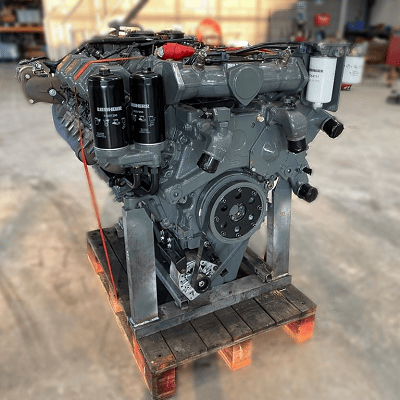The process of a dyno test on a Liebherr engine

When it comes to heavy machinery, reliability and power are paramount. Liebherr, a name synonymous with innovation and excellence in engineering, stands tall as a pioneer in the realm of heavy equipment and machinery. From towering cranes to robust excavators, Liebherr’s engineering prowess extends to the heart of these machines. We delve into the world of dyno testing a Liebherr engine, uncovering the meticulous process behind unleashing the raw power concealed within.
The foundation of excellence
Before we embark on the journey of dyno testing, it’s crucial to understand the foundation upon which Liebherr engines are built. With decades of engineering expertise and commitment to quality, Liebherr engines are crafted to withstand the most demanding environment and deliver unparalleled performance. Each component is meticulously designed and rigorously tested to ensure reliability, efficiency and longevity.
The process
1 Preparation: The engine undergoes meticulous preparation before being mounted onto the dynamo meter. This includes ensuring all connections are secure, fluids are filled to the appropriate levels, and sensors are properly calibrated.
2 Mounting: The engine is carefully mounted onto the dynamometer, a specialized device designed to simulate real-world operating conditions. Precision is paramount during this step to ensure accurate results.
3 Initial checks: Once mounted, a series of initial checks are conducted to verify proper alignment, connection integrity, and functionality of all engine systems.
4 Warm-up: The engine is started and allowed to warm up to operating temperature. This ensures consistent results and minimizes the risk of damage during testing.
5 Baseline testing: With the engine warmed up , baseline tests are conducted to establish initial performance metrics. This includes measuring power output, torque, fuel consumption, and emissions at various RPM levels.
6 Load testing: The engine is subjected to progressively increasing loads to simulate different operating conditions, such as idle, partial load and full load. This allows engineers to assess performance across the entire operating range and identify any potential issues or optimization.
7 Data analysis: Throughout the testing process, data is continuously collected and analyzed in real-time. Advanced instrumentation and software are used to monitor performance metrics and identify trends or anomalies.
8 Optimazation: Based on the data analysis, adjustments may be made to optimize engine performance. This could involve fine-tuning fuel injection timing, adjusting air-fuel ratios, or optimize turbocharger boost pressure.
9 Validation: Once testing is complete, the results are meticulously reviewed and validated against predetermined criteria and specifications. Any deviations or anomalies are thoroughly investigated to ensure accuracy and reliability.
10 Reporting: Finally, a comprehensive report is generated detailing the results of the dyno testing, including performance metrics, observations, and any recommendations for further optimization or refinement.
The outcome of dyno testing
Dyno testing a Liebherr engine is more than just a routine procedure – it’s a testament to the unwavering commitment to excellence that defines Liebherr’s engineering philosophy. By subjecting their engines to rigorous testing and analysis, Liebherr ensures that each engine delivers the uncompromising performance, reliability, and efficiency that customers expect.
In conclusion, dyno testing a Liebherr engine is not just about measuring power output. It’s about unlocking the true potential of these remarkable engines and ensuring they exceed expectations in the most challenging environments imaginable.
Sanitary Ware Profile Extrusion Dies
Aluminum alloy sanitary ware refers to products made of aluminum alloy materials in sanitary products. Aluminum alloy is a metal material with the characteristics of light weight, high strength and good corrosion resistance, so it is widely used in sanitary products.
Aluminum alloy sanitary products include shower rooms, bathtubs, wash basins, toilet accessories, etc. These products usually use aluminum alloy frames, combined with other materials such as glass, ceramics, etc., to achieve beautiful and practical designs.
Aluminum alloy sanitary products have the following advantages:
1. Lightweight: Aluminum alloy materials are relatively light, making sanitary products easier to install and transport.
2. High strength: Aluminum alloy has high strength and can provide solid support and durability.
3. Good corrosion resistance: Aluminum alloy has good corrosion resistance and can resist the erosion of sanitary products by water vapor, humidity and other environments.
4. Easy to clean: The aluminum alloy surface is smooth and not easy to accumulate dirt, making it more convenient to use.
5. Beautiful appearance: Aluminum alloy sanitary products usually adopt modern designs and diverse color choices, which can meet the aesthetic needs of different consumers.
In short, aluminum alloy sanitary ware products have become a popular product in the sanitary ware market due to their lightweight, high strength, and good corrosion resistance. They not only provide a comfortable use experience, but also add a sense of modernity and style to the sanitary space.
Sanitary Ware Profile Extrusion Molds,Sanitary Ware Profile Extrusion Moulds,Sanitary Ware Extrusion Dies,Sanitary Ware Extrusion Molds
Foshan Jieliwei Metal Products Co., Ltd. , https://www.foshanjlw.com
